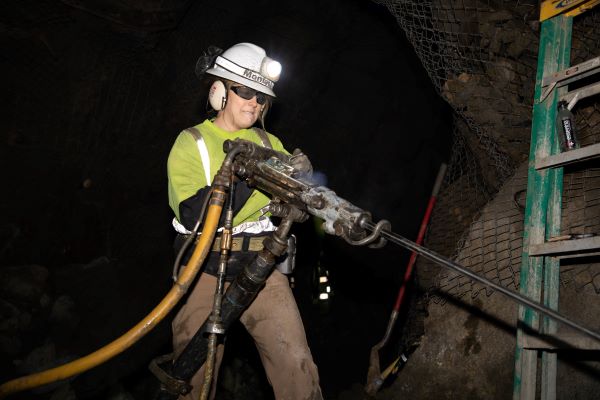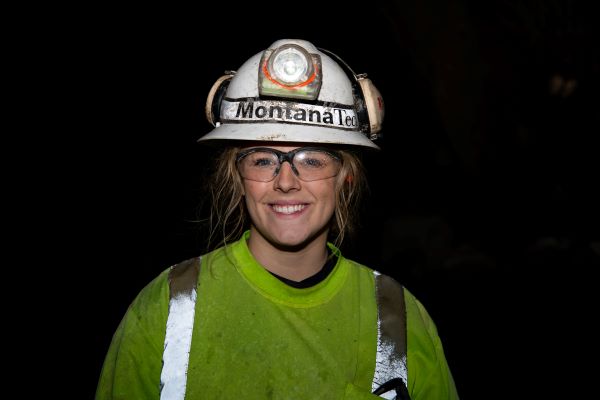Freshman solidifies passion for mining in Underground Mine Education Center, lands summer internship

A major cornerstone of a Montana Technological University education is the internship component. The University has built its reputation on hands-on learning that takes place inside and outside of the classroom. Juniors and seniors are known for spending their summers in exciting locations in the field. But one Montana Tech freshman may have landed a summer internship in record time.
Jordan Niggemyer is a mining and environmental engineering freshman from Grafton, West Virginia, who has impressively secured a summer internship before midterms of her first semester on campus. In her short time at Montana Tech, Niggemyer has laid the groundwork to become an ambassador for the mining industry.
“Jordan’s hometown of Grafton sits just a short drive from the West Virginia University’s campus and their Mining Engineering program but when it came time for Jordan to select a school to help her achieve her goal of improving reclamation and restoration projects from the “inside out,” she didn’t land close to home, she chose Montana Tech,” Assistant Professor of Mining Engineering Christopher Roos said. “In fact, a total of 4 of the 14 Mining Engineering programs in the United States are within a 5-hour drive of Grafton, but Jordan saw that Montana Tech was uniquely positioned to provide her with the educational experience she desired and the small school atmosphere that would enable her to thrive. As a natural leader, Jordan has become active in several extracurricular activities in her short time at Montana Tech and I am excited to see where her education and career take her.”
Niggemyer’s journey starts with the coal mines in West Virginia. Her father worked there as a union rep before later becoming an attorney.
“I wanted to go into something that I know and love,” Niggemyer said. “I wanted the small school vibe because I’m from a small town.”

When Niggemyer visited campus, she found a second home.
“I fell in love,” Niggemyer said. “We came for a campus tour in July. It was incredible. We found out more about the historical side of the area. They really gave me that homey vibe.”
During the tour, Niggemyer went into the Underground Mine Education Center (UMEC). The UMEC is a hands-on, interdisciplinary educational space consisting of the former Orphan Boy and Orphan Girl Mines located immediately west of campus. It is the nation’s only on-campus underground mining facility, and is home to courses for mining engineering, geological engineering, environmental engineering, metallurgical engineering, and occupational safety and health. It also serves as a research facility.
“I knew immediately this was where I wanted to be,” Niggemyer said. She went straight to the Registrar’s office during Freshmen Orientation, to request placement into an introductory class that would put her in the UMEC for four hours a week.
“I learned more in four hours than I did in four years of high school,” Niggemyer said.
The class has been focused on working on the east heading. They are learning how to construct ground supports and blasts.
“I got to push the button last week,” Niggemyer said. “I had never been around explosives of that measure. Tannerite does not compare to what we use. The blasts we are doing are significantly bigger and louder. We have to wear double ear protection.”
One of the standard mining skills students learn in the UMEC is jackleg drilling. A jackleg drill is a piece of technology that greatly increased productivity in the mining industry during the Industrial Revolution. A pneumatic “leg” is used to change the height of the drill, which is used to drill holes in the surface of rocks. Those holes are filled with explosives to blast the rocks.
Because of the nature of the blasts, students have to learn about safety protocols quickly.
“We take a lot of extra measures to ensure our students are safe, especially when we are doing our jacklegs or our blasts,” Niggemyer said. “We have a lot of large rocks that tend to fall, but we are aware of that. When we set our blast, we can account for that. It’s going to make our ground a little weaker, but that’s why we have our ground supports.”
The class also requires lots of mucking, which consists of shoveling dirt by hand.
“My first day down there, I had to hand muck,” Niggemyer said. “It’s hard work, but it’s rewarding.”
This class requires students to get dirty.
“When we come out, we have circles around our eyes, covered in dirt,” Niggemyer said. “We wear our scrappy clothes because they get coated in oil and mud from jackleg drilling. When you come out of the UMEC, you round the corner, and there’s daylight. The first thing you see when you come out is the headframe with the American flag on it. It’s so cool because you are like an underground person. You are just in the earth when you are down there.”
After connecting with Arch Resources at Montana Tech’s Fall Career Fair, Niggemyer will intern in a West Virginia coal mine this summer. It’s the same mine her father used to work at. She’s looking forward to getting covered in coal dust, and learning more about the industry.
But first, she’s got to get through the 46th International Collegiate Mining Competition, which will be held at Montana Tech this year. Categories in the event include hand steel drilling, jackleg drilling, Swede saw, survey, gold panning, track stand, and hand mucking. Teams from around the world are invited to attend.
In addition to finding her professional calling on campus, Niggemyer says her time at Montana Tech has been highlighted by making new friends.
“I think Mining Engineering might be the best department, just in the manner that we are a tight-knit family,” Niggemyer said. “Those are my brothers and sisters, without a doubt. I was immediately adopted and had 50 friends the second I got here who I can call at any time.”
She hopes to maintain those connections as she moves through her career. She plans to work as a mining engineer for several years before moving into mining reclamation.
“So many coal mines in West Virginia were not shut down properly and it caused a lot of problems in communities,” Niggemyer said. “I don’t think I can solve the problems without understanding the source.”
Niggemyer is also encouraged by the direction the mining industry is moving.
“As we move into having more green energy in America, a lot of people don’t understand that while mining did have a lot of problems in the past, we are moving faster than other nations in going green,” Niggemyer said. “Everyone knows there have been issues, but we have moved faster than almost any other industry at working through those issues. These companies are doing the work.”